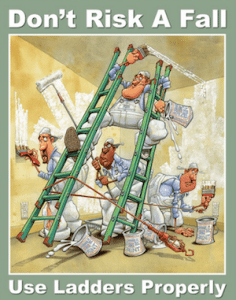Painting seems to be one of the easiest projects, when in reality it can poses potential hazards if not carried out properly.
Giving due respect to the task and following some simple yet effective safety guidelines, will not only ensure a successful project, but will also make sure you come off with the project without a mishap.
A painting project should not turn into a trip to the hospital emergency room. It is therefore important for you to follow some essential safety measures when you set out to paint a building. Read along to find out 5 safety tips, which should always be followed by painters.
Reaching and painting the top successfully, requires the use of the right ladder in the right manner. Just about everything you to need to know about ladders are generally printed on it. Read every single label to learn how to use the ladder to keep you safe.
- Before using the ladder, make sure you inspect the rungs to see if they’re intact and dirt free so that nothing interferes with footing.
- When using an extension ladder, ensure the tops of both rails make solid contact with walls and both legs make firm contact with the ground.
- Also check that the spreader bar is completely extended and locked in place.
- Use Ladder locks and stabilizers where like these where needed.
-
Power Washers
Power washers, spray painting equipments and power sanders are a painter’s best friend – but only till the time when they’re used properly, by correctly following the manufacturer’s guidelines.
- Make sure you wear protective eye and head gear while handling power washers.
- Don’t forget to attach nozzles or associated accessories before turning on the water supply.
- Allow the machine to run several minutes before you begin with power-washing.
-
Personal Protective Equipment
Good painting practices dictates that skin, eyes and lungs should always be protected. You can accomplish this by purchasing the right set of safety gloves, goggles and respirator.
- Leather or fabric gloves are extremely important while scraping, patching, sanding and wire-brushing.
- Eye goggles are recommended during scraping, wire-brushing, patching and sanding overhead. Eye goggles are a must when dealing with bleach, acids or other chemicals.
- Dust mask should be used when sanding. In case you are handling a sprayer, it is important you use an organic vapor respirator to avoid breathing spray paint into your lungs.
-
Working With Solvents
At times, painters use pure solvents for thinning paints, dissolving pigments and adjusting drying times. While solvents are not inherently dangerous, but improper management of the material can affect your health in many ways.
- Ensure proper ventilation in places you paint. If the rooms have windows keep them open.
- Don’t forget to wear protective eye gear.
- Have suitable fire extinguisher nearby.
-
General Safety Precautions
Although, painting is not a dangerous practice, but it always pays to follow good safety practices. Carelessness is the quickest way to get you into hazardous situation and painting is no exception.
- Keep others out of the area
- Do not burn off old paint
- Remove all possible sources of ignition
Don’t let children play with paint. Always spread plastic sheets or newspaper. After the work is done, do make sure to leave the room or space absolutely clean.
About Author: – Bob Fortune is a professional writer & worked as a Customer Service at Fortune Restoration. Fortune Restoration is one of the best companies in Chicago for providing Services like Painting, Restoration services for residential homeowners from Hyde Park to Lincoln Park.
Connect with Bob Fortune
Facebook Google Plus Twitter Pinterest


